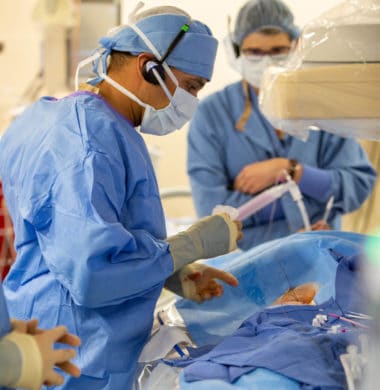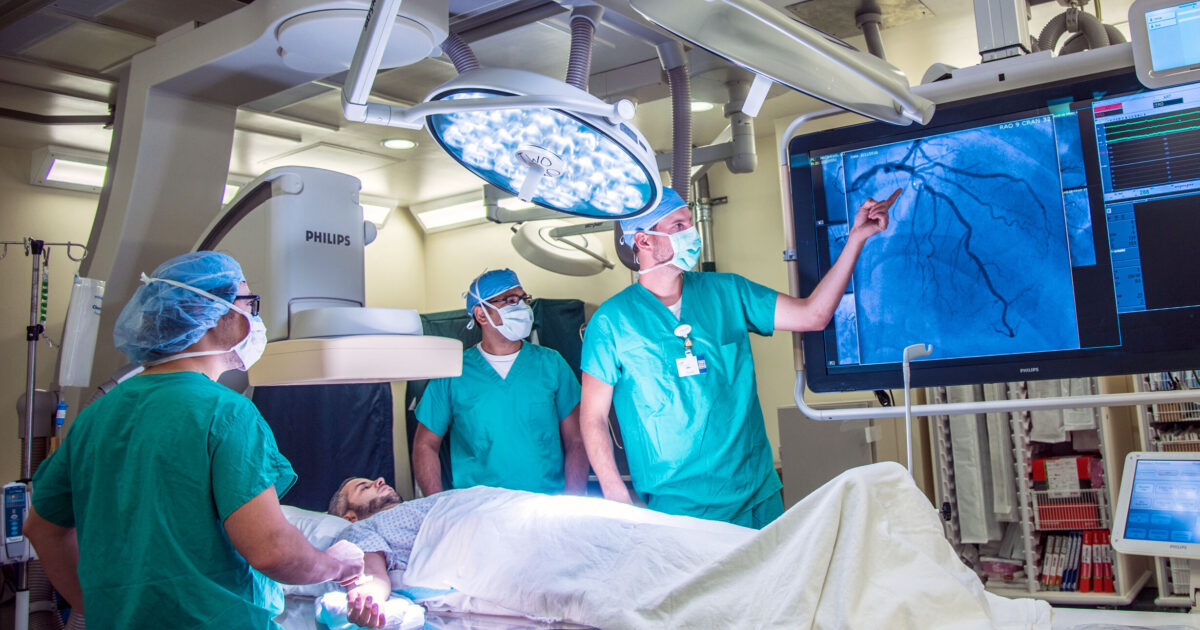The ultimate heart health checklist from Cardiology Jupiter
The ultimate heart health checklist from Cardiology Jupiter
Blog Article
Recognizing the Relevance of Cardiology in Modern Health Care Services
Cardiology plays a vital role in modern health care, particularly as cardiovascular disease remains to be the leading root cause of mortality worldwide. Advances in diagnostics and therapy have changed person care, allowing earlier interventions and enhanced end results. The change towards preventive cardiology equips people to manage their health proactively. As modern technology remains to advance, the combination of innovative services may better redefine cardiology's effect on public wellness, motivating a more detailed exam of arising fads and their implications.
The Prevalence of Cardiovascular Disease and Its Influence On Public Health
Heart illness remains the leading cause of death globally, its influence expands far beyond individual clients to influence public health systems and economic climates. The high frequency of cardiovascular disease places a substantial pressure on healthcare resources, demanding raised financing for prevention, rehab, and treatment programs. Public health and wellness campaigns have to resolve threat elements such as excessive weight, smoking, and inactive way of livings, which contribute greatly to the increasing occurrence of heart conditions.Moreover, the economic concern connected with heart disease is immense, incorporating not only direct medical costs however additionally indirect costs associated with lost efficiency and early death. Areas deal with obstacles in managing these expenses, usually bring about variations in health care accessibility and end results. As the population ages and lifestyle-related risks remain to rise, the urgency for effective cardiology interventions becomes critical. Dealing with heart disease is not only a matter of individual health and wellness yet also a crucial public wellness concern.
Breakthroughs in Cardiac Diagnostics and Imaging Techniques
Current developments in heart diagnostics and imaging strategies have transformed the field of cardiology, improving the capacity to find and keep an eye on heart problem. Methods such as cardiac MRI, CT angiography, and echocardiography have actually come to be significantly sophisticated, supplying detailed pictures of cardiac frameworks and features. These techniques enable the very early identification of problems like coronary artery disease, heart failure, and valvular disorders.Moreover, developments in non-invasive diagnostics, such as wearable innovation and remote surveillance devices, have actually encouraged people and doctor. These devices promote real-time tracking of heart rhythms and various other crucial indicators, resulting in timely interventions. In addition, man-made intelligence is being integrated right into imaging evaluation, enhancing precision and efficiency in diagnosis.
Advancements in Treatment Alternatives for Heart Issues
Current advancements in cardiology have actually resulted in considerable developments in therapy alternatives for heart problems. These include sophisticated surgical techniques that boost step-by-step outcomes and emerging medicines that provide new opportunities for therapy. As the area progresses, these innovations play an important duty in improving individual treatment and outcomes.
Advanced Surgical Techniques
Developments in surgical strategies have actually changed the landscape of cardiology, offering brand-new expect clients with heart disease. Minimally intrusive treatments, such as catheter-based interventions, have actually significantly lowered recuperation times and medical facility keeps. Methods like robotic-assisted surgical treatment improve accuracy, permitting doctors to browse complex physiological structures with better accuracy. In addition, innovations in imaging innovation assist in real-time visualization throughout procedures, boosting end results. Transcatheter aortic valve substitute (TAVR) exhibits a breakthrough in dealing with aortic constriction, enabling valve substitute without open-heart surgery. Additionally, hybrid techniques that incorporate catheter-based and surgical techniques provide tailored options for numerous cardiac problems. These innovative medical techniques not just boost client safety but additionally broaden therapy alternatives, highlighting the essential duty of advancement in modern cardiology techniques.
Arising Medications and Therapies
As the landscape of cardiology continues to advance, arising treatments and medications play a crucial role in enhancing therapy alternatives for heart conditions. Innovations such as novel anticoagulants and progressed lipid-lowering representatives have actually transformed the management of heart diseases, substantially lowering patient morbidity and death. In addition, the growth of gene treatments and regenerative medication supplies encouraging avenues for treating problems formerly regarded irreparable. Medical tests are constantly exposing the effectiveness of these treatments, pushing the borders of traditional therapies. The integration of digital wellness innovations promotes individualized medicine, allowing for tailored therapy plans based on hereditary and way of life aspects. Jointly, these improvements highlight the vibrant nature of cardiology, boosting individual outcomes and redefining requirements of treatment in contemporary healthcare.
The Role of Preventive Cardiology in Patient Care
Precautionary cardiology plays a necessary duty in individual care by focusing on the identification of risk factors that add to heart disease. Via way of living adjustment techniques and very early discovery methods, medical care carriers can properly lower the occurrence of cardio occasions - Cardiology. This aggressive approach not just enhances person results however likewise promotes long-term health and wellness
Risk Aspect Recognition
While heart diseases remain a leading reason for morbidity and mortality worldwide, reliable danger variable identification works as a keystone of preventive cardiology. Determining threat variables such as high blood pressure, family, hyperlipidemia, and diabetic issues background is crucial for very early intervention. Medical care professionals utilize numerous evaluating techniques to assess these factors, permitting for customized safety nets. Furthermore, comprehending a patient's way of living options, such as smoking cigarettes and physical inactivity, additionally notifies risk evaluations. This complete evaluation enables medical professionals to establish tailored treatment strategies focused on mitigating threats. By prioritizing danger aspect recognition, healthcare systems can enhance person end results and decrease the overall worry of cardio conditions, ultimately contributing to improved public health and wellness approaches and source allotment.
Way Of Life Alteration Techniques
A plethora of studies highlights the vital duty of way of life alteration methods in reducing cardiovascular disease risk. These approaches encompass nutritional changes, increased exercise, smoking cessation, and weight monitoring. By adopting a heart-healthy diet plan rich in fruits, vegetables, entire grains, and lean healthy proteins, individuals can reduce cholesterol levels and high blood pressure. Regular physical task enhances the heart and improves overall cardio health and wellness. Additionally, stopping smoking cigarettes significantly reduces the threat of heart problem and improves recovery rates for those with status quo. Weight administration even more adds to cardio health by minimizing various other threat aspects such as diabetes mellitus and high blood pressure. Implementing these lifestyle alters not just promotes individual wellness but likewise functions as a keystone of precautionary cardiology in individual treatment.
Early Discovery Methods
Lifestyle alterations greatly add to reducing cardio disease dangers, however they are most reliable when coupled with early detection methods. Preventive cardiology emphasizes the relevance of determining potential heart issues before they rise into serious conditions. Techniques such as high blood pressure monitoring, cholesterol screening, and advanced imaging modern technologies like echocardiograms play important duties in evaluating cardiovascular health and wellness. Biomarkers and genetic testing also enhance the precision of very early discovery, enabling website link for tailored precautionary strategies. Normal cardiac danger examinations encourage healthcare carriers to step in proactively, potentially stopping cardiovascular disease and strokes (Dr Garcia). By integrating these very early detection approaches right into regular care, people can gain from timely way of life interventions and targeted therapies, inevitably improving results and boosting lifestyle
Integrating Innovation Into Cardiology Practices
As improvements in technology proceed to reshape various fields, the assimilation of ingenious devices and systems right into cardiology techniques has actually come to be necessary for enhancing person care and results. Telemedicine systems allow cardiologists to keep track of individuals from another location, enhancing access to care while lowering the worry on medical care centers. Wearable devices, such as smartwatches, make it possible for continuous heart price tracking, informing both people and doctors to prospective issues in real-time. In addition, expert system (AI) is being used to analyze substantial amounts of cardiac information, assisting in early medical diagnosis and tailored therapy plans. Advanced imaging strategies, including 3D echocardiography, enhance visualization of heart structures, leading to a lot more exact interventions. Electronic health and wellness documents (EHRs) improve person information monitoring, making sure that cardiologists have instant access to crucial information. With each other, these technical advancements are changing cardiology, promoting proactive administration and boosted health and wellness end results for clients with cardio problems.
The Importance of Person Education and Engagement
Individual education and interaction play an essential function in the administration of cardio wellness. By outfitting patients with knowledge about their conditions, therapy choices, and way of living changes, doctor empower people to take an energetic role in their treatment. This aggressive approach can lead to improved adherence to recommended medications, nutritional adjustments, and workout programs, inevitably lowering the danger of complications.Engagement additionally promotes a solid patient-provider connection, urging open communication and count on. When people really feel informed and included, they are most likely to voice problems and ask questions, which can cause far better scientific outcomes. Furthermore, academic resources, such as workshops or electronic systems, can boost understanding and advertise self-management go to this web-site strategies. On the whole, prioritizing patient education and learning and interaction is important for enhancing cardiovascular wellness, enhancing lifestyle, and reducing medical care prices connected with cardiovascular conditions.
Future Trends in Cardiology and Their Prospective Effect

Frequently Asked Inquiries
What Way Of Living Adjustments Can Lower Cardiovascular Disease Threat?
The existing inquiry addresses lifestyle changes that can significantly decrease cardiovascular disease threat. Cardiology care. Embracing a balanced diet regimen, taking part in regular exercise, maintaining a healthy and balanced weight, taking care of anxiety, and preventing tobacco can notably boost cardiovascular wellness
How Can I Recognize Very Early Indicators of Heart Issues?
Acknowledging very early indications of heart troubles involves tracking signs and symptoms such as upper body discomfort, lack of breath, tiredness, and uneven heartbeat. Timely awareness of these signs can motivate required medical examination and intervention for much better end results.
What Are the Distinctions In Between Cardiologists and Cardiac Surgeons?
The differences in between cardiologists and cardiac specialists lie in their duties; cardiologists mainly diagnose and manage heart disease through non-invasive approaches, while cardiac doctors do procedures to fix architectural heart problems. Each plays an important, distinctive function.

Exactly how Frequently Should I Get My Heart Wellness Checked?
The regularity of heart checkup varies based on individual threat variables. Usually, grownups ought to undertake evaluations each to 2 years, while those with status quo may call for even more constant assessments as recommended by healthcare professionals.
What Duty Does Genes Play in Heart Problem Risk?
Genetics greatly affects heart condition threat, with familial patterns indicating inherited problems. Particular genes can predispose people to hypertension, cholesterol issues, and other cardio problems, highlighting the relevance of hereditary screening in evaluating heart wellness. Heart disease continues to be the leading cause of fatality internationally, its effect expands far past specific people to affect public health systems and economic climates. Public health and wellness campaigns have to address risk variables such as excessive weight, smoking cigarettes, and inactive way of lives, read what he said which add substantially to the climbing occurrence of heart conditions.Moreover, the economic burden linked with heart disease is enormous, encompassing not just straight medical expenses but also indirect costs connected to lost efficiency and early mortality. Preventative cardiology plays an important function in client treatment by concentrating on the recognition of risk elements that add to heart disease. Fabricated intelligence (AI) and maker understanding are improving diagnostics and client surveillance, allowing very early discovery of heart illness. The distinctions between cardiologists and cardiac cosmetic surgeons lie in their duties; cardiologists mostly manage and identify heart problems with non-invasive approaches, while heart specialists carry out medical procedures to correct architectural heart issues.
Report this page